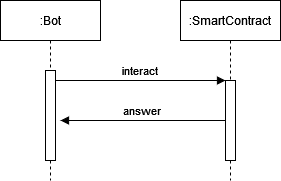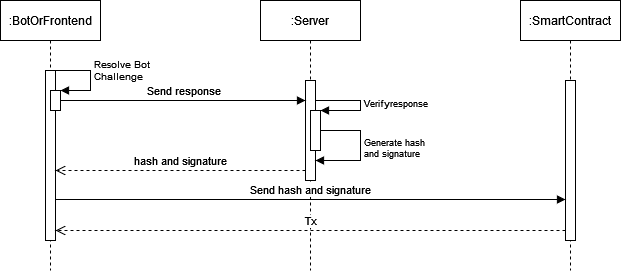Create a fair NFT mint on Ethereum with Solidity and NextJS #1: Introduction & Web setup



Selling NFTs to your community is harder than ever
ERC-721 has been a great standard for tokenized collectibles. Easily customizable, you can create a lot of different ways to sell and distribute collectibles to your community.
Sadly, it doesn't support any kind of bot protection out of the box, and boy these bots can get annoying.
- ➡️ They are faster than humans by seconds
- ➡️ They amplify the disparity between the richest buyers and the lesser by driving the gas fees to high levels
- ➡️ They will create network congestion and slow down the Ethereum network
There have been a number of attempts to create a solution to this problem, like Civic smart-contracts that can be used to verify the identity of the buyer, thus slowing down a lot of bots. But with the surge of high gas prices, it's currently not possible to create a solution on the blockchain that will be sustainable.
Web2 to the rescue
Bots have been an issue for a decade in the Web2 ecosystem hence why there's so much anti-bots solutions existing and making life harder for the bots. Akamai, Datadome, Cloudflare, reCaptcha are some of the most popular anti-bot solutions and even if a few bypass exist (btw checkout this great repo where we analyze Akamai Bot Protection), I would recommend using one of them whenever you are dealing with high traffic on critical production servers. So why not try to integrate one of these solutions into your Web3 project?
How can it help?
Let's say you are implementing a classic NFT minting system on the Ethereum blockchain. You would most likely use a ERC-721 smart contract to store the tokens and a basic frontend to interact with the smart contract. As we said before, the main caveat here is leaving the door open for bots to purchase the tokens directly from the smart contract without using the frontend.

With similar tools to the ones used in Web2 we could mitigate this behavior and slow down bots.
But how are we going to integrate our Web2 solutions into our NFT minting system?
In definitive what we want to do is force a bot challenge to be solved by the user. To achieve this we're going to create an extra-step to the minting process which require to call and wait for a response from a given backend.

As you can see, the server add an extra step between the smart contract and the bot/front-end. You can add any type of bot protection with this system as the bot will always require a valid response from the backend to be validated by the smart contract.
Futhermore, we make sure that the verification is obligatory. How? Our smart contract, that we will detail in this post, will require that the hash sent by the user has been signed by a designated account controlled by the owner of the smart contract. The same account will be used to sign the hash sent by the user in our back-end. Attackers would need to find out the private key of the account to sign the hash and bypass our verification.
Implementation with NextJS and reCaptcha
Let's create a simple example of how to integrate reCaptcha into your minting website.
Pre-minting
On a classic NFT minting system, you would interact directly with Metamask and send a request to mint a token. With our system, we will first need to send a request to the backend to validate the user's response to the reCaptcha challenge.
Client-side
type Body = { account: string // Ethereum account address amount: number // Number of tokens to mint captcha: string // Response to the reCaptcha challenge } export type Data = { hash?: string // A hash representing an object {account, amount, nonce} signature?: string // Signature of the hash nonce?: string // Nonce used to generate the hash message?: string // A potential error message } const API_MINT = '/mint' // Endpoint to mint tokens export const preMint = async (props: Body): Promise<Data> => { const res = await fetch(API_MINT, { body: JSON.stringify(props), headers: new Headers({ "content-type": "application/json" }), method: "POST" }); return res.json(); }
Server-side
First, we verify the user's response to the reCaptcha challenge. If the user fails the challenge, we return an error.
const signerPrivateKey = process.env.SIGNER_PRIVATE_KEY; const { account, amount, recaptcha } = req.body; const ip = getIp(req) if (process.env.RECAPTCHA_SECRET) { const recaptchaResponse = await recaptchaSolving({response: recaptcha, ip}) if (recaptchaResponse.success === false) { const message = "error" return res.status(403).json({ message: "Captcha verification failed" }) } }
Then we generate a keccak256 hash of the user's account, amount of token, generated nonce, and finally sign it with the owner private key, and return it to the user.
const nonce = crypto.randomBytes(9).toString("base64"); const content = web3.utils.soliditySha3( { type: "address", value: account }, { type: "uint256", value: amount }, { type: "string", value: nonce } ); const Web3 = new web3(); // Generate the signature const { messageHash: hash, signature } = await Web3.eth.accounts.sign(content, signerPrivateKey) // Send back res.status(200).json({ hash, signature, nonce })
That's where the magic happens. The account signing the hash is secret as it's located server-side, making it mandatory to go through the backend to submit a valid transaction to the smart contract.
Finally we just need to call the smart contract with the retrieved data to mint the tokens.
export const mint = async (props: {hash: string, signature: string, nonce: string, tokenQuantity: number}) => { const {hash, signature, nonce, tokenQuantity} = props; // Data from the previous request const web3 = new Web3(window.ethereum); const networkId = await web3.eth.net.getId(); const networkAddress = process.env.NEXT_PUBLIC_SMARTCONTRACT_ADDRESS; // @ts-ignore const contract = new web3.eth.Contract(SmartContract.abi, networkAddress); const address = await window.ethereum.request({ method: 'eth_accounts' })[0]; // The `buy` method requires the following parameters: // - hash: The hash of the mint data // - signature: The signature of the hash // - nonce: The nonce used to generate the hash // - tokenQuantity: The number of tokens to mint // We will detail this method in a later post const res = await contract.methods.buy(hash, signature, nonce, tokenQuantity).call({from: address}); }
In the next post we'll learn how to integrate this solution into our smart contract.
Check out the GitHub repository for the full source.